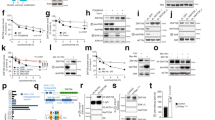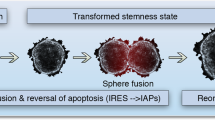Abstract
The Lats2 tumor suppressor protein has been implicated earlier in promoting p53 activation in response to mitotic apparatus stress, by preventing Mdm2-driven p53 degradation. We now report that Lats2 also has a role in an ATR-Chk1-mediated stress check point in response to oncogenic H-Ras. Activated mutant H-Ras triggers the translocation of Lats2 from centrosomes into the nucleus, coupled with an increase in Lats2 protein levels. This leads to the induction of p53 activity, upregulation of proapoptotic genes, downregulation of antiapoptotic genes and eventually apoptotic cell death. Many of the cells that survive apoptosis undergo senescence. However, a fraction of the cells escape this checkpoint mechanism, despite maintaining a high mutant H-Ras expression. These escapers display increased genome instability, as evidenced by a substantial fraction of cells with micronuclei and cells with polyploid genomes. Interestingly, such cells show markedly reduced levels of Lats2, in conjunction with enhanced hypermethylation of the Lats2 gene promoter. Our findings suggest that Lats2 might have an important role in quenching H-Ras-induced transformation, whereas silencing of Lats2 expression might serve as a mechanism to enable tumor progression.
This is a preview of subscription content, access via your institution
Access options
Subscribe to this journal
Receive 50 print issues and online access
$259.00 per year
only $5.18 per issue
Buy this article
- Purchase on Springer Link
- Instant access to full article PDF
Prices may be subject to local taxes which are calculated during checkout






Similar content being viewed by others
References
Abulaiti A, Fikaris AJ, Tsygankova OM, Meinkoth JL . (2006). Ras induces chromosome instability and abrogation of the DNA damage response. Cancer Res 66: 10505–10512.
Aylon Y, Michael D, Shmueli A, Yabuta N, Nojima H, Oren M . (2006). A positive feedback loop between the p53 and Lats2 tumor suppressors prevents tetraploidization. Genes Dev 20: 2687–2700.
Bartek J, Bartkova J, Lukas J . (2007). DNA damage signalling guards against activated oncogenes and tumour progression. Oncogene 26: 7773–7779.
Bartkova J, Rezaei N, Liontos M, Karakaidos P, Kletsas D, Issaeva N et al. (2006). Oncogene-induced senescence is part of the tumorigenesis barrier imposed by DNA damage checkpoints. Nature 444: 633–637.
Bean GR, Bryson AD, Pilie PG, Goldenberg V, Baker Jr JC, Ibarra C et al. (2007). Morphologically normal-appearing mammary epithelial cells obtained from high-risk women exhibit methylation silencing of INK4a/ARF. Clin Cancer Res 13 (22 Part 1): 6834–6841.
Burri N, Shaw P, Bouzourene H, Sordat I, Sordat B, Gillet M et al. (2001). Methylation silencing and mutations of the p14ARF and p16INK4a genes in colon cancer. Lab Invest 81: 217–229.
Chang HC, Cho CY, Hung WC . (2006). Silencing of the metastasis suppressor RECK by RAS oncogene is mediated by DNA methyltransferase 3b-induced promoter methylation. Cancer Res 66: 8413–8420.
Denko N, Stringer J, Wani M, Stambrook P . (1995). Mitotic and post mitotic consequences of genomic instability induced by oncogenic Ha-ras. Somat Cell Mol Genet 21: 241–253.
Ding L, Getz G, Wheeler DA, Mardis ER, McLellan MD, Cibulskis K et al. (2008). Somatic mutations affect key pathways in lung adenocarcinoma. Nature 455: 1069–1075.
Esteller M . (2008). Epigenetics in cancer. N Engl J Med 358: 1148–1159.
Fikaris AJ, Lewis AE, Abulaiti A, Tsygankova OM, Meinkoth JL . (2006). Ras triggers ataxia-telangiectasia-mutated and Rad-3-related activation and apoptosis through sustained mitogenic signaling. J Biol Chem 281: 34759–34767.
Halazonetis TD, Gorgoulis VG, Bartek J . (2008). An oncogene-induced DNA damage model for cancer development. Science 319: 1352–1355.
Jiang K, Pereira E, Maxfield M, Russell B, Goudelock DM, Sanchez Y . (2003). Regulation of Chk1 includes chromatin association and 14-3-3 binding following phosphorylation on Ser-345. J Biol Chem 278: 25207–25217.
Jiang Z, Li X, Hu J, Zhou W, Jiang Y, Li G et al. (2006). Promoter hypermethylation-mediated down-regulation of LATS1 and LATS2 in human astrocytoma. Neurosci Res 56: 450–458.
Jimenez-Velasco A, Roman-Gomez J, Agirre X, Barrios M, Navarro G, Vazquez I et al. (2005). Downregulation of the large tumor suppressor 2 (LATS2/KPM) gene is associated with poor prognosis in acute lymphoblastic leukemia. Leukemia 19: 2347–2350.
Kim JS, Lee C, Bonifant CL, Ressom H, Waldman T . (2007). Activation of p53-dependent growth suppression in human cells by mutations in PTEN or PIK3CA. Mol Cell Biol 27: 662–677.
Li Y, Pei J, Xia H, Ke H, Wang H, Tao W . (2003). Lats2, a putative tumor suppressor, inhibits G1/S transition. Oncogene 22: 4398–4405.
Lowe SW . (1999). Activation of p53 by oncogenes. Endocr Relat Cancer 6: 45–48.
Mallette FA, Gaumont-Leclerc MF, Ferbeyre G . (2007). The DNA damage signaling pathway is a critical mediator of oncogene-induced senescence. Genes Dev 21: 43–48.
McDermott KM, Zhang J, Holst CR, Kozakiewicz BK, Singla V, Tlsty TD . (2006). p16(INK4a) prevents centrosome dysfunction and genomic instability in primary cells. PLoS Biol 4: e51.
Milyavsky M, Shats I, Erez N, Tang X, Senderovich S, Meerson A et al. (2003). Prolonged culture of telomerase-immortalized human fibroblasts leads to a premalignant phenotype. Cancer Res 63: 7147–7157.
Phelps ED, Updike DL, Bullen EC, Grammas P, Howard EW . (2006). Transcriptional and posttranscriptional regulation of angiopoietin-2 expression mediated by IGF and PDGF in vascular smooth muscle cells. Am J Physiol Cell Physiol 290: C352–C361.
Ponzio TA, Yue C, Gainer H . (2007). An intron-based real-time PCR method for measuring vasopressin gene transcription. J Neurosci Methods 164: 149–154.
Pruitt K, Ulku AS, Frantz K, Rojas RJ, Muniz-Medina VM, Rangnekar VM et al. (2005). Ras-mediated loss of the pro-apoptotic response protein Par-4 is mediated by DNA hypermethylation through Raf-independent and Raf-dependent signaling cascades in epithelial cells. J Biol Chem 280: 23363–23370.
Reynolds PA, Sigaroudinia M, Zardo G, Wilson MB, Benton GM, Miller CJ et al. (2006). Tumor suppressor p16INK4A regulates polycomb-mediated DNA hypermethylation in human mammary epithelial cells. J Biol Chem 281: 24790–24802.
Serrano M . (1997). The tumor suppressor protein p16INK4a. Exp Cell Res 237: 7–13.
Shema E, Tirosh I, Aylon Y, Huang J, Ye C, Moskovits N et al. (2008). The histone H2B-specific ubiquitin ligase RNF20/hBRE1 acts as a putative tumor suppressor through selective regulation of gene expression. Genes Dev 22: 2664–2676.
Strazisar M, Mlakar V, Glavac D . (2009). LATS2 tumour specific mutations and down-regulation of the gene in non-small cell carcinoma. Lung Cancer 64: 257–269.
Takahashi Y, Miyoshi Y, Takahata C, Irahara N, Taguchi T, Tamaki Y et al. (2005). Down-regulation of LATS1 and LATS2 mRNA expression by promoter hypermethylation and its association with biologically aggressive phenotype in human breast cancers. Clin Cancer Res 11: 1380–1385.
Toji S, Yabuta N, Hosomi T, Nishihara S, Kobayashi T, Suzuki S et al. (2004). The centrosomal protein Lats2 is a phosphorylation target of Aurora-A kinase. Genes Cells 9: 383–397.
Vazquez A, Bond EE, Levine AJ, Bond GL . (2008). The genetics of the p53 pathway, apoptosis and cancer therapy. Nat Rev Drug Discov 7: 979–987.
Ventura A, Kirsch DG, McLaughlin ME, Tuveson DA, Grimm J, Lintault L et al. (2007). Restoration of p53 function leads to tumour regression in vivo. Nature 445: 661–665.
Voorhoeve PM, le Sage C, Schrier M, Gillis AJ, Stoop H, Nagel R et al. (2006). A genetic screen implicates miRNA-372 and miRNA-373 as oncogenes in testicular germ cell tumors. Cell 124: 1169–1181.
Wang W, El-Deiry WS . (2008). Restoration of p53 to limit tumor growth. Curr Opin Oncol 20: 90–96.
Xue W, Zender L, Miething C, Dickins RA, Hernando E, Krizhanovsky V et al. (2007). Senescence and tumour clearance is triggered by p53 restoration in murine liver carcinomas. Nature 445: 656–660.
Yabuta N, Okada N, Ito A, Hosomi T, Nishihara S, Sasayama Y et al. (2007). Lats2 is an essential mitotic regulator required for the coordination of cell division. J Biol Chem 282: 19259–19271.
Acknowledgements
We thank Doron Ginsberg, Reuven Agami and Scott Lowe for the generous gift or plasmids and the following people for other help: Lior Golomb (β-gal staining), Efrat Shema (migration assays) and Sylvia Wilder (excellent technical help). We were supported in part by Grant R37 CA40099 from the National Cancer Institute, EC FP6 Grant LSHC-CT-2004-503576, FP7 funding (ONCOMIRS, agreement 201102), the Dr Miriam and Sheldon Adelson Medical Research Foundation and the Yad Abraham Center for Cancer Diagnosis and Therapy. The EC is not liable for any use that may be made of the information contained herein.
Author information
Authors and Affiliations
Corresponding author
Additional information
Supplementary Information accompanies the paper on the Oncogene website (http://www.nature.com/onc)
Supplementary information
Rights and permissions
About this article
Cite this article
Aylon, Y., Yabuta, N., Besserglick, H. et al. Silencing of the Lats2 tumor suppressor overrides a p53-dependent oncogenic stress checkpoint and enables mutant H-Ras-driven cell transformation. Oncogene 28, 4469–4479 (2009). https://doi.org/10.1038/onc.2009.270
Received:
Revised:
Accepted:
Published:
Issue Date:
DOI: https://doi.org/10.1038/onc.2009.270
Keywords
This article is cited by
-
The Hippo kinase LATS2 impairs pancreatic β-cell survival in diabetes through the mTORC1-autophagy axis
Nature Communications (2021)
-
A prospect of cell immortalization combined with matrix microenvironmental optimization strategy for tissue engineering and regeneration
Cell & Bioscience (2019)
-
Dishevelled has a YAP nuclear export function in a tumor suppressor context-dependent manner
Nature Communications (2018)
-
p53 shades of Hippo
Cell Death & Differentiation (2018)
-
The LATS1 and LATS2 tumor suppressors: beyond the Hippo pathway
Cell Death & Differentiation (2017)



